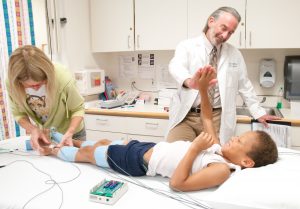Overview
Cerebral palsy (CP) is a group of neurological disorders that affect movement, muscle tone, and posture, primarily due to damage to the developing brain. There is currently no cure for cerebral palsy, but various treatments can help manage symptoms, improve mobility, and enhance quality of life. Treatment approaches are individualized based on the type and severity of CP, as well as the specific needs and goals of each person.
The primary goals of cerebral palsy treatment are to promote independence, alleviate pain, and improve motor function. A multidisciplinary approach is often taken, involving physical, occupational, and speech therapies, as well as medications, assistive devices, and sometimes surgical interventions. Physical therapy helps with muscle strength and coordination, while occupational therapy focuses on improving daily living skills. Speech therapy is beneficial for those with speech and communication challenges.
Medications may be used to manage symptoms such as muscle stiffness, spasticity, and seizures, while surgical procedures can help correct skeletal and muscular abnormalities. Orthotic devices, such as braces, walkers, and wheelchairs, provide support and improve mobility. Newer therapies, such as stem cell therapy and robotic-assisted training, are also being explored as potential treatments to enhance outcomes for those with CP.
With consistent, tailored interventions, individuals with cerebral palsy can maximize their abilities, gain greater independence, and achieve an improved quality of life. Early diagnosis and intervention are crucial to creating an effective treatment plan and ensuring the best possible outcomes.
Table of Contents
When to See a Doctor
Seeking medical advice early can play a critical role in managing cerebral palsy effectively. If you notice any developmental delays or unusual muscle tone or movement patterns in your child, it’s essential to consult a healthcare professional. Early diagnosis allows for timely intervention, which can help maximize a child’s potential and improve long-term outcomes.
- Developmental Delays. If a child is not reaching developmental milestones, such as rolling over, sitting up, or walking, at expected ages, it may indicate motor development issues. Consult a doctor if these delays persist, as early assessment can identify potential concerns.
- Abnormal Muscle Tone. Children with cerebral palsy may have overly stiff or floppy muscles. If your child’s muscles feel unusually rigid or loose, or if they struggle with control of muscle movements, seek a medical evaluation.
- Uncoordinated or Abnormal Movements. Involuntary movements, tremors, or difficulty with coordinated movements, such as reaching for objects or walking, may be signs of cerebral palsy. A doctor can assess whether these are normal developmental variations or signs of a neurological condition.
- Persistent Reflexes. Babies typically outgrow certain reflexes by a specific age. If primitive reflexes, such as the Moro reflex (startle reflex), persist beyond the expected time, it could indicate developmental issues that warrant further investigation.
- Difficulty Swallowing or Speaking. Some children with cerebral palsy may struggle with swallowing or speech development. If your child has difficulty feeding, swallowing, or communicating, consult a healthcare provider who can assess their needs and recommend appropriate therapies.
- Seizures or Other Neurological Symptoms. If your child experiences seizures or other signs of neurological issues, it’s important to see a doctor immediately. Seizures are sometimes associated with cerebral palsy, and early management can reduce complications.
Timely medical intervention for cerebral palsy can greatly improve quality of life, offering support through therapies, medications, and assistive devices tailored to the child’s unique needs. Regular follow-ups and early intervention services provide essential support to maximize a child’s independence and capabilities.
Cerebral Palsy Treatment Options
 Image Source: shrinerschildrens.org
Image Source: shrinerschildrens.org
Medications and Treatments for Cerebral Palsy
As mentioned, there is no cure for cerebral palsy, but various treatments are available to manage symptoms and improve quality of life. People with cerebral palsy typically require long-term care from a team of specialists, each playing a unique role in addressing the condition’s various aspects. This team-based approach ensures that the physical, cognitive, and emotional needs of the individual are met comprehensively.
Here are some of the key specialists involved in cerebral palsy treatment:
- Pediatrician. The pediatrician is often the primary doctor for a child with cerebral palsy, responsible for creating and coordinating a treatment plan. They oversee the child’s overall health and development, serving as the central figure in the care team.
- Pediatric Neurologist. This specialist focuses on the child’s nervous system, diagnosing and managing brain and nerve-related issues. They help monitor and treat any neurological complications associated with cerebral palsy.
- Psychologist or Psychiatrist. A mental health specialist assesses the child’s cognitive and emotional development, providing support and therapy to address any behavioral or psychological issues. This support is especially important for children who may struggle with frustration, anxiety, or social interactions.
- Speech-Language Pathologist. Speech therapists help children with speech difficulties and oral issues, such as trouble swallowing. They work on improving communication skills, which can enhance social interactions and overall quality of life.
- Orthopedic Surgeon. When surgical intervention is necessary to correct bone and muscle deformities, an orthopedic surgeon is involved. They perform procedures to improve mobility and reduce pain, helping the child maintain functional movement.
- Physical Therapist. Physical therapists focus on improving the child’s physical capabilities, such as strength, coordination, and walking. They design exercises and activities that promote better posture, muscle tone, and mobility.
- Occupational Therapist. Unlike physical therapists, occupational therapists concentrate on teaching the child how to perform everyday tasks, such as dressing and eating. They also help the child learn how to use assistive devices like crutches, braces, or wheelchairs to increase independence.
- Developmental Therapist. This therapist works on teaching age-appropriate social and behavioral skills, helping the child interact with peers and understand social cues. They focus on skills that promote independence and participation in typical childhood activities.
- Recreational Therapist. Recreational therapists engage the child in leisure activities such as sports, art, and games. These activities help improve physical abilities, boost self-esteem, and provide opportunities for socialization and enjoyment.
- Special Education Teacher. Children with cerebral palsy who experience learning difficulties may benefit from special education. These teachers provide tailored educational support, ensuring the child receives the necessary accommodations to succeed academically.
Through the coordinated efforts of this team, individuals with cerebral palsy can achieve a higher quality of life, better functional abilities, and improved social skills. Early and consistent intervention is essential, as it helps the child reach developmental milestones, enhances independence, and promotes overall well-being. If you suspect that your child may have cerebral palsy, seek an evaluation from a healthcare provider to start a comprehensive care plan.
Cerebral Palsy Prognosis
The prognosis for individuals with cerebral palsy varies widely based on the severity of the condition, the type of cerebral palsy, and the level of medical and therapeutic support available. While cerebral palsy is a lifelong condition that does not have a cure, early diagnosis and consistent intervention can significantly improve an individual’s abilities, independence, and quality of life.
- Mild Cerebral Palsy. Individuals with mild cerebral palsy often experience minimal motor limitations and may not require extensive medical support. With physical and occupational therapy, they can often achieve a high degree of independence, participate in school and social activities, and lead fulfilling lives.
- Moderate Cerebral Palsy. For those with moderate cerebral palsy, symptoms may impact mobility and daily activities more significantly. However, with proper therapies, assistive devices, and sometimes surgical interventions, individuals with moderate cerebral palsy can learn to navigate daily life, attend school, and participate in community activities, albeit with some adaptations.
- Severe Cerebral Palsy. Individuals with severe cerebral palsy may face considerable physical and intellectual challenges. They may require ongoing support for daily activities and assistance from caregivers. While some may experience limited independence, personalized therapy, specialized education, and adaptive equipment can enhance their quality of life, provide avenues for communication and interaction, and support meaningful engagement with others.
- Cognitive and Emotional Development. Not all individuals with cerebral palsy experience cognitive challenges. Many have normal intellectual abilities and can excel academically and socially with the right support. For those who do face cognitive or emotional challenges, mental health support, specialized education, and therapy can foster cognitive growth and emotional resilience.
- Quality of Life and Life Expectancy. With advances in medical care and therapy, many people with cerebral palsy live well into adulthood, and life expectancy is often close to that of the general population, especially for those with milder forms. Consistent healthcare, nutritional support, and management of associated conditions (such as epilepsy or respiratory issues) are essential in promoting longevity and quality of life.
In summary, the prognosis for cerebral palsy largely depends on the individual’s specific needs and the quality of medical and therapeutic care they receive. Early intervention and a multidisciplinary approach that addresses physical, cognitive, and emotional needs can help individuals with cerebral palsy maximize their potential, gain independence, and enjoy a fulfilling life. Regular follow-up with healthcare providers and personalized support tailored to each person’s strengths and challenges are crucial for optimizing outcomes.


